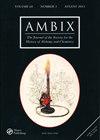March of the Pigments: Color History, Science and Impact
IF 0.6
3区 哲学
Q3 HISTORY & PHILOSOPHY OF SCIENCE
引用次数: 1
Abstract
tant practical knowledge was to rulers and statecraft as part of a princely collection or Kunstkammer. In the fourth and final part, the book moves most explicitly beyond The Body of the Artisan as it reflects Smith’s experience of collaborative research in laboratory reconstruction of instructions fromMs. Fr. 640, a Frenchmanuscript of art and craft practices that forms the core of Smith’s Making and Knowing Project at Columbia University. Here she distills the core insight that the anonymous author-practitioner of this sixteenth-century collection was primarily interested in the categorisation of materials by manipulating, hypothesising, and testing them – a working method that goes well beyond the trial and error typically identified as the artisanalmodus operandi. This may also be the part of the book that speaks most to the interests of the readers of this journal, as it reveals an epistemically productive fascination with material transformation that was the core business of alchemy in the early modern period. This part concludes with a search for alternative formulations to Kunst to describe this cognitive activity, culminating in the final sentence of the book where it is called “material imaginary,” “fundamental structuring categories,” “artisanal epistemology,” and a “mode of work,” among other things. Confronted with the same limitations of language that vexed early modern artisans, Smith is on a similar quest for creative descriptions and translations. Indeed, at its most basic level, the book tries to grasp and make explicit in words what practical knowledge is; and herein lies the most significant difference with Smith’s previous monograph. As the subtitle of The Body of the Artisan: Art and Experience in the Scientific Revolution suggests, it situated artisanal epistemology in relation to science. Traces of this approach remain, but From Lived Experience to the Written Word primarily defines practical knowledge on its own terms. Characteristically, the book ends with an epilogue on “Global Routes of Practical Knowledge” in which Smith starts to undo the Eurocentric assumptions of the concept of the Scientific Revolution. There are books which close the discussion by offering the final word, and others which open fields by drastically altering the terms of discussion. From Lived Experience to the Written Word is a perfectly crafted book belonging to the latter category.颜料进行曲:色彩历史、科学与影响
对于统治者和治国方略来说,重要的实用知识是王子收藏或Kunstkammer的一部分。在第四部分也是最后一部分,这本书最明确地超越了《艺术家的身体》,因为它反映了史密斯在实验室重建Ms指令方面的合作研究经验。Fr.640,一个关于艺术和工艺实践的法国手稿,构成了哥伦比亚大学史密斯制作和了解项目的核心。在这里,她提炼出了一个核心见解,即这本16世纪作品集的匿名作者从业者主要对材料的分类感兴趣,通过操纵、假设和测试这些材料——这种工作方法远远超出了通常被认为是手工操作的试错。这也可能是本书中最符合本杂志读者兴趣的部分,因为它揭示了对物质变革的认识上的富有成效的迷恋,而物质变革是现代早期炼金术的核心业务。这一部分的结尾是寻找昆斯特的替代表述来描述这种认知活动,最终在书的最后一句中被称为“物质想象”、“基本结构类别”、“手工认识论”和“工作模式”等。面对困扰早期现代工匠的语言限制,史密斯也在寻求创造性的描述和翻译。事实上,在最基本的层面上,这本书试图抓住并用语言明确什么是实践知识;这与史密斯以前的专著有着最显著的区别。正如《艺术家的身体:科学革命中的艺术与经验》的副标题所表明的那样,它将艺术认识论与科学联系起来。这种方法的痕迹仍然存在,但《从生活经验到书面文字》主要根据自己的条件定义实践知识。具有特色的是,这本书以“全球实践知识之路”的结语结尾,史密斯在结语中开始推翻科学革命概念的以欧洲为中心的假设。有些书通过提供最后的话语来结束讨论,还有一些书通过大幅改变讨论条件来打开领域。《从生活经验到文字》是一本精心制作的书,属于后一类。
本文章由计算机程序翻译,如有差异,请以英文原文为准。
求助全文
约1分钟内获得全文
求助全文
来源期刊

Ambix
HISTORY & PHILOSOPHY OF SCIENCE-
CiteScore
0.80
自引率
60.00%
发文量
42
审稿时长
3 months
期刊介绍:
Ambix is an internationally recognised, peer-reviewed quarterly journal devoted to publishing high-quality, original research and book reviews in the intellectual, social and cultural history of alchemy and chemistry. It publishes studies, discussions, and primary sources relevant to the historical experience of all areas related to alchemy and chemistry covering all periods (ancient to modern) and geographical regions. Ambix publishes individual papers, focused thematic sections and larger special issues (either single or double and usually guest-edited). Topics covered by Ambix include, but are not limited to, interactions between alchemy and chemistry and other disciplines; chemical medicine and pharmacy; molecular sciences; practices allied to material, instrumental, institutional and visual cultures; environmental chemistry; the chemical industry; the appearance of alchemy and chemistry within popular culture; biographical and historiographical studies; and the study of issues related to gender, race, and colonial experience within the context of chemistry.
 求助内容:
求助内容: 应助结果提醒方式:
应助结果提醒方式:


